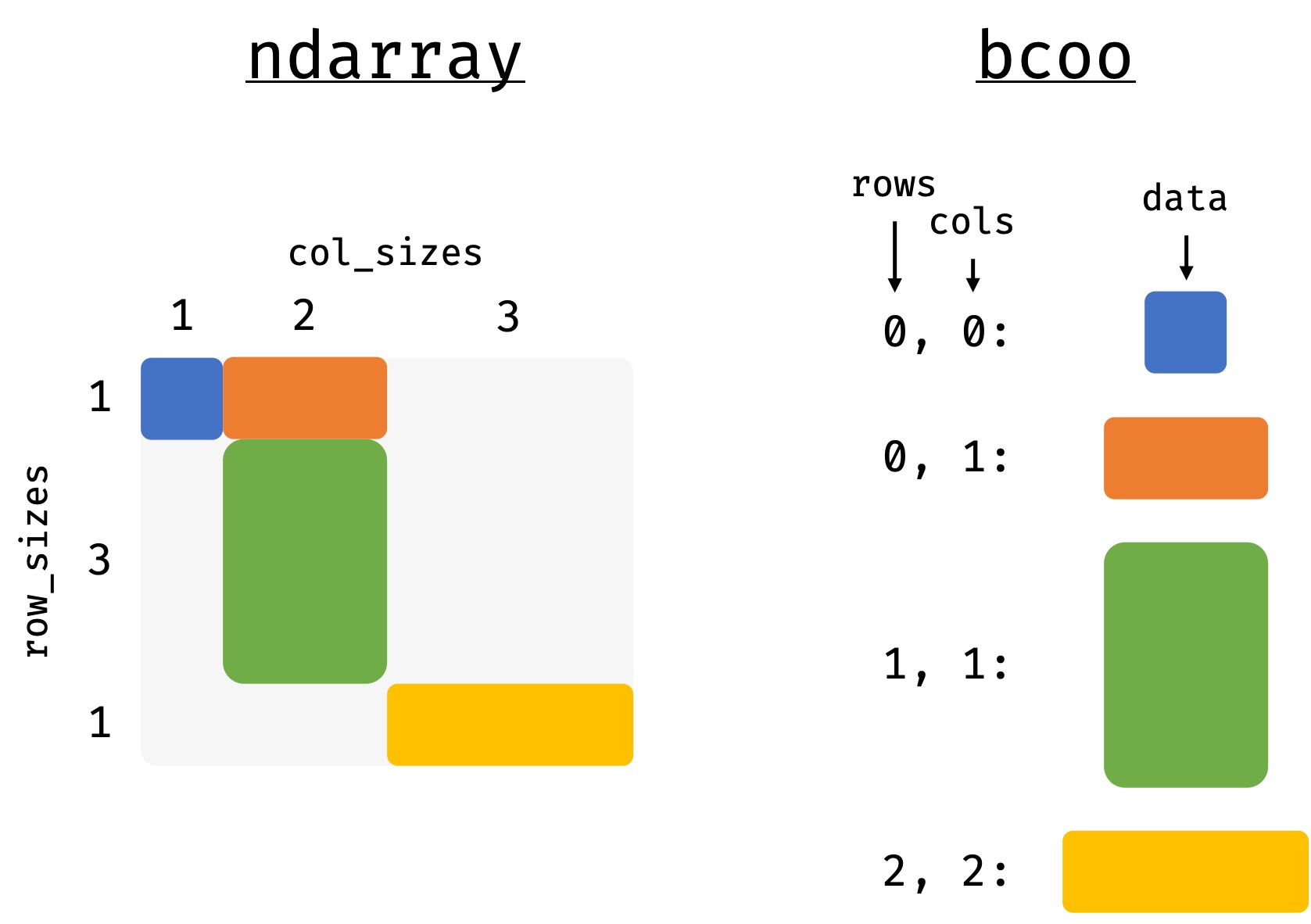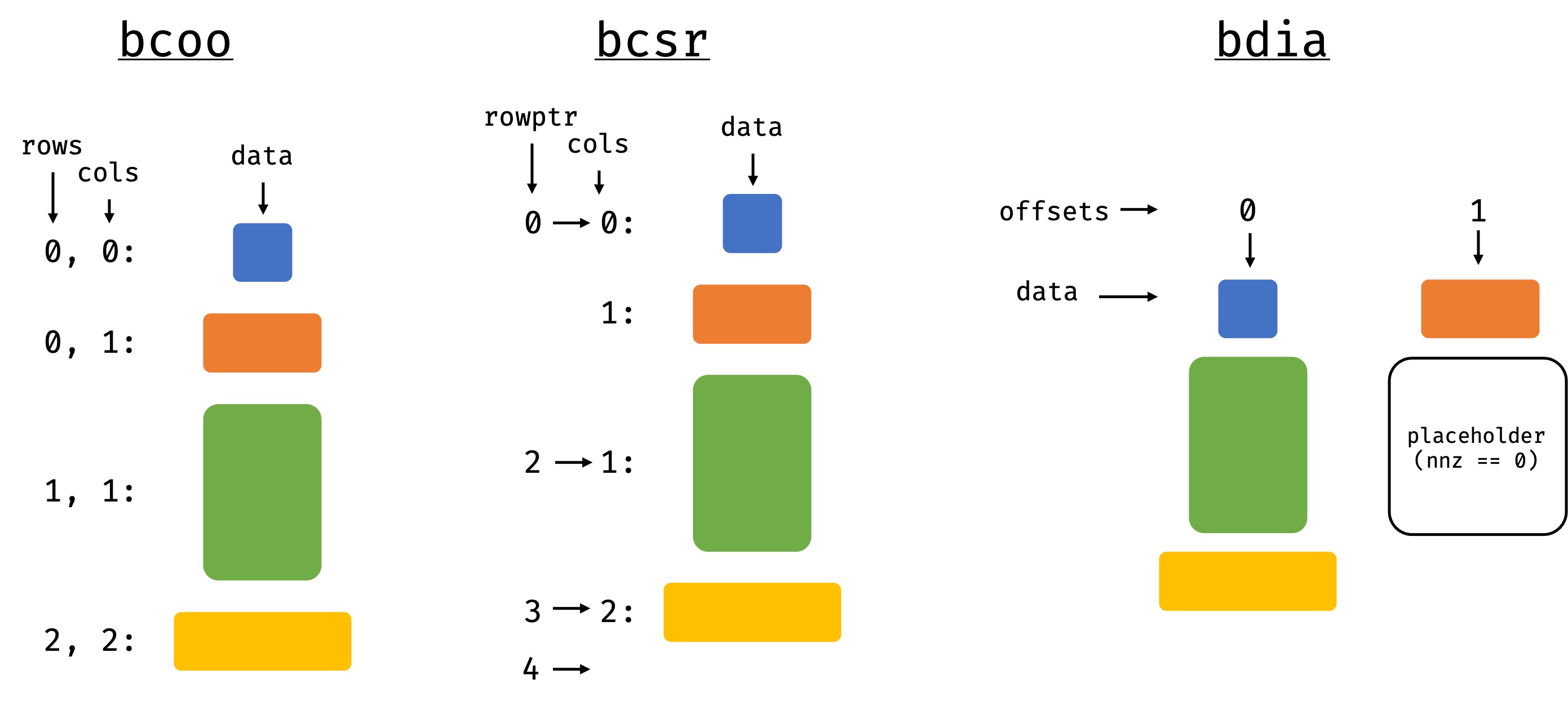Sparse Matrix Containers#
Just like sparse matrices store individual scalars, bsparse’s sparse matrix containers generalize this concept to storing arbitrary-type 2D sub-blocks.
This type of coarse-grained sparsity structure is often found in deep learning applications, in regression calculations, in finite-element discretizations, and in other discretizations of operators onto basis functions with small support.
It can be more natural to work with objects that can be accessed and modified block-by-block and one can also gain a computational advantage employing sparse matrix containers for certain algorithms like selected matrix inversion or selected matrix multiplication.
The sub-blocks in bsparse matrices have to be aligned, i. e. they must
not be ragged. This way we can define a set of row-sizes
(.row_sizes) and column-sizes (.col_sizes). The sub-blocks are
aligned on the grid that these values span. To create a bsparse matrix
from a dense array, we need to specify the row- and column-sizes.

>>> import bsparse as bsp
>>> import numpy as np
>>> arr = np.zeros((5, 6))
>>> arr[0, 0] = 1
>>> arr[0, 1:3] = 2
>>> arr[1:4, 1:3] = 3
>>> arr[-1, 3:] = 4
>>> arr
array([[1., 2., 2., 0., 0., 0.],
[0., 3., 3., 0., 0., 0.],
[0., 3., 3., 0., 0., 0.],
[0., 3., 3., 0., 0., 0.],
[0., 0., 0., 4., 4., 4.]])
>>> row_sizes = [1, 3, 1]
>>> col_sizes = [1, 2, 3]
>>> bcoo = bsp.BCOO.from_array(arr, (row_sizes, col_sizes))
>>> bcoo
BCOO(bshape=(3, 3), bnnz=4 | shape=(5, 6), nnz=12)
Like scalar-element sparse matrices, the corresponding dense array can
be represented in several equivalent ways. The only difference is that
the .data is now a list of sub-blocks rather than a dense array of
scalars.
>>> bcoo.data
[
array([[1.]]),
array([[2., 2.]]),
array([[3., 3.],
[3., 3.],
[3., 3.]]),
array([[4., 4., 4.]])
]
This can now be again converted to the different sparse representations.
>>> bcoo.tocsr()
BCSR(bshape=(3, 3), bnnz=4 | shape=(5, 6), nnz=12)
>>> bcoo.todia()
BDIA(bshape=(3, 3), bnnz=5 | shape=(5, 6), nnz=12)

All bsparse matrices have a datatype of the underlying scalars
(.dtype), a 2D matrix shape (.shape), a number of explicitly
stored values (.nnz), and a symmetry attribute (.symmetry).
>>> bcoo.dtype
dtype('float64')
>>> bcoo.shape
(5, 6)
>>> bcoo.nnz
12
>>> bcoo.symmetry # None
In addition they have attributes describing the block-structure. These
are the shape in terms of blocks (.bshape), the number of explicitly
stored blocks (.bnnz), and the row- and column-sizes mentioned
before.
>>> bcoo.bshape
(3, 3)
>>> bcoo.bnnz
4
>>> bcoo.row_sizes
array([1, 3, 1])
>>> bcoo.col_sizes
array([1, 2, 3])
Again, all arithmetic operations are supported.
>>> (bcoo * bcoo + 2*bcoo) @ bcoo.T
BCOO(bshape=(3, 3), bnnz=5 | shape=(5, 5), nnz=17)
In addition, the blocks stored in a bsparse matrix can be modified using
the .bapply() function. This maps a callable argument onto all the
stored blocks.
>>> >>> bcoo.bapply(lambda b: b**2)
BCOO(bshape=(3, 3), bnnz=4 | shape=(5, 6), nnz=12)
